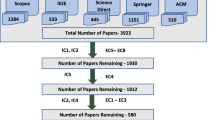Abstract
Sequential pattern mining is a process of knowledge discovery which finds the frequent subsequence as a mode from the sequence database. Web log database is typically dynamic. Web log records are generated constantly, and user access patterns will change accordingly. This study focused on taking advantage of the dynamic characteristics of the Web access database, delivering a fast and efficient incremental mining algorithm. An IncWTP algorithm suitable for Web access sequence mode is developed to handle non-simple path with dynamic data storage structure, and detect and delete the failed sequence data timely.
















Similar content being viewed by others
References
Shi H et al (2012) Association between PPAR-γ and RXR-α gene polymorphism and metabolic syndrome risk: a case-control study of a Chinese han population. Arch Med Res 43(3):233–242
Lee CKM, Lam JSL (2012) Managing reverse logistics to enhance sustainability of industrial marketing. Ind Mark Manage 41(4):589–598
Zeiler A, Faltermeier R (2013) Weighted sliding empirical mode decomposition for online analysis of biomedical time series. Neural Process Lett 37(1):21–32
Aras N, Aksen D, Gönül A (2008) Tanuğur, Locating collection centers for incentive-dependent returns under a pick-up policy with capacitated vehicles. Eur J Oper Res 191(3):1223–1240
Alagador D, Cerdeira JO (2007) Designing spatially-explicit reserve networks in the presence of mandatory sites. Biol Conserv 137(2):254–262
Brandão SN, Sauer J, Schön I (2010) Circumantarctic distribution in Southern Ocean benthos? A genetic test using the genus Macroscapha (Crustacea, Ostracoda) as a model. Mol Phylogenet Evol 55(3):1055–1069
Kerh T, Gunaratnam D, Chan YL (2010) Neural computing with genetic algorithm in evaluating potentially hazardous metropolitan areas result from earthquake. Neural Comput Appl 19(4):521–529
Timotheou Stelios (2011) A novel weight initialization method for the random neural network. Neurocomputing 56(1):345–363
Dash NB et al (2010) Hybrid neural modeling for groundwater level prediction. Neural Comput Appl 19(8):1251–1263
Dehuri S, Cho SB (2010) A hybrid genetic based functional link artificial neural network with a statistical comparison of classifiers over multiple datasets. Neural Comput Appl 19(2):317–328
Liu D (2014) Network site optimization of reverse logistics for E-commerce based on genetic algorithm. Neural Comput Appl 25:67–71
Ilgin MA, Gupta SM (2010) Environmentally conscious manufacturing and product recovery (ECMPRO): a review of the state of the art. J Environ Manage 91(3):563–591
Cordova J, Yu W (2013) Two types of haar wavelet neural networks for nonlinear system identification. Neural Process Lett 35(3):283–300
Kerh T, Gunaratnam D, Chan YL (2010) Neural computing with genetic algorithm in evaluating potentially hazardous metropolitan areas result from earthquake. Neural Comput Appl 19(4):521–529
Acampora G, Gaeta M, Loia V (2011) Hierarchical optimization of personalized experiences for e-Learning systems through evolutionary models. Neural Comput Appl 20(5):641–657
Dash NB et al (2010) Hybrid neural modeling for groundwater level prediction. Neural Comput Appl 19(8):1251–1263
Dehuri S, Cho SB (2010) A hybrid genetic based functional link artificial neural network with a statistical comparison of classifiers over multiple datasets. Neural Comput Appl 19(2):317–328
Acknowledgments
The research on which this paper reports has been financially supported by Natural Science Foundation of Zhejiang Province by Project LY15G020021and Zhejiang Provincial Social Science Fund by Project 15JDXX02YB.
Author information
Authors and Affiliations
Corresponding author
Rights and permissions
About this article
Cite this article
Liu, D., Cai, S. & Guo, X. Incremental sequential pattern mining algorithms of Web site access in grid structure database. Neural Comput & Applic 28, 575–583 (2017). https://doi.org/10.1007/s00521-015-2096-4
Received:
Accepted:
Published:
Issue Date:
DOI: https://doi.org/10.1007/s00521-015-2096-4




